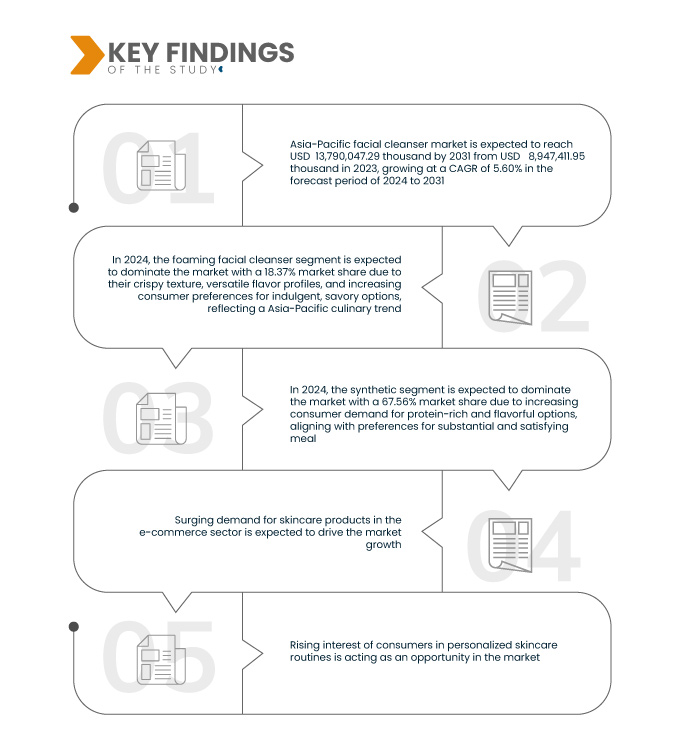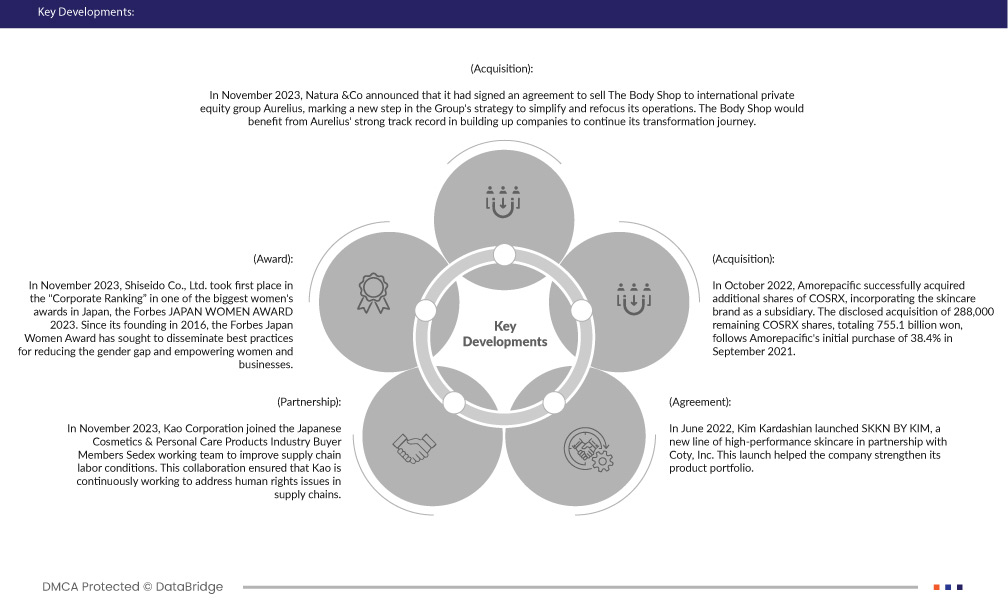The ever-growing influence of e-commerce platforms has reshaped consumer habits and profoundly impacted the beauty and skincare industry. This trend is driven by transformative power of online retail in the skincare domain. The Asia-Pacific facial cleanser market has witnessed a remarkable surge, largely driven by the exponential growth of the e-commerce sector. The convenience, extensive product range, and personalized shopping experiences offered by online platforms have reshaped consumer behaviors and profoundly impacted the skincare industry.
The convenience, Asia-Pacific reach, and influence of online platforms reshape consumer behaviors and preferences for skincare brands. The Asia-Pacific facial cleanser market is marked by intense competition driven by factors such as evolving consumer preferences, the emergence of indie brands, personalized skincare trends, luxury brand entries, and ongoing product innovation. As a result, consumers are presented with a wide array of choices, and brands are compelled to differentiate themselves through unique formulations, marketing strategies, and a focus on sustainability to gain a competitive edge in this dynamic market. Thus, the surge in the skincare market from the e-commerce sector serves as a potent driver for market growth.
Access Full Report @ https://www.databridgemarketresearch.com/reports/asia-pacific-facial-cleanser-market
Data Bridge Market Research analyzes that the Asia-Pacific Facial Cleanser Market is expected to grow with a CAGR of 5.60% from 2024 to 2031 and is expected to reach USD 13,790,047.29 thousand by 2031.
Key Findings of the Study
Rising demand for organic and natural products is expected to drive the market growth
The Asia-Pacific facial cleanser market is experiencing significant growth as consumers increasingly prioritize organic and natural products for skincare. In recent years, consumers have become increasingly conscious of the ingredients in their skincare products, fueling a significant shift towards cleaner and greener choices. This trend is underpinned by a growing understanding of the potential benefits of organic and natural formulations.
Consumers are particularly drawn to products that are safe, eco-friendly, and packaged sustainably. Retailers are prominently featuring organic and natural skincare products as the market expands Asia-Pacific, with a noticeable shift away from chemically formulated alternatives. The future outlook for the organic skincare market is optimistic, driven by factors such as increasing consumer awareness, rising disposable incomes, changing lifestyles, environmental concerns, and a growing emphasis on sustainability, The industry is poised for promising growth, fueled by education, awareness, a rising millennial population, and the increasing presence of working women.
This consumer-driven shift not only reflects a desire for effective skincare but also mirrors a broader commitment to health, sustainability, and ethical choices in personal care routines. Skincare brands embracing this trend are well-positioned to thrive in a market where consciousness and choice intersect. Thus, the rising awareness of organic and natural products is driving market growth.
Report Scope and Market Segmentation
|
Report Metric
|
Details
|
|
Forecast Period
|
2024 to 2031
|
|
Base Year
|
2023
|
|
Historic Years
|
2022 (Customizable to 2016-2021)
|
|
Quantitative Units
|
Revenue in USD Thousand
|
|
Segments Covered
|
Type (Foaming Facial Cleanser, Gel Facial Cleanser, Cream & Lotion Facial Cleanser, Oil Facial Cleanser, No Foam Cleanser, Micellar Water, Bar Facial Cleanser, Solvent Facial Cleanser, Collagen Type Cleanser, Cleansing Cotton Pads, and Others), Source (Synthetic and Natural/Herbal), Packaging Type (Bottles and Jars, Tubes, Dispenser, Pouches, Blisters and Strip Packs, and Others), Skin Type (Combination Skin, Oily Skin, Neutral Skin, Dry Skin, Sensitive Skin, Mixed Skin, and Others), Application (Moisturizing, Skin Whitening, Oiliness, Anti-Aging, Blackheads, Dark Spots, Repair, Dryness, and Others), Price Range (Mass and Premium), Age Group (20’s and 30’s, 40’s, Less Than 20 Years, and 50’s+), Cost (Less than 25 USD, 25 – 50 USD, 51 – 100 USD, 101 – 250 USD, and More Than 250 USD), Target Customer (Female and Male), End Use (Household/Retail, Parlor, Modelling and Fashion Agencies, Movies and Entertainment, Media Houses, and Others), Distribution Channel (Offline and Online)
|
|
Countries Covered
|
China, Japan, South Korea, India, Australia, Indonesia, Singapore, Taiwan, Thailand, Malaysia, Philippines, Vietnam, New Zealand, and Rest of Asia-Pacific
|
|
Market Players Covered
|
Unilever (U.K.), Procter & Gamble (U.S.), L'Oréal Paris (France), Estée Lauder Inc (U.S.), Shiseido Co.,Ltd. (Japan), Johnson & Johnson Consumer Inc. (U.S.), Amorepacific (South Korea), Kao Corporation (Japan), Group L’OCCITANE (Switzerland), Sephora USA, Inc. (U.S.), Coty Inc. (France), Clarins (U.S.), Caudalie (France), Natura&Co (Brazil), and Beiersdorf AG (Germany), among others
|
|
Data Points Covered in the Report
|
In addition to the insights on market scenarios such as market value, growth rate, segmentation, geographical coverage, and major players, the market reports curated by the Data Bridge Market Research also include in-depth expert analysis, geographically represented company-wise production and capacity, network layouts of distributors and partners, detailed and updated price trend analysis and deficit analysis of supply chain and demand
|
Segment Analysis
The Asia-Pacific facial cleanser market is segmented into eleven segments based on product type, source, packaging type, skin type, application, price range, age group, cost, target customer, end use, and distribution channel.
- On the basis of product type, the market is segmented into foaming facial cleanser, gel facial cleanser, cream & lotion facial cleanser, oil facial cleanser, no foam cleanser, micellar water, bar facial cleanser, solvent facial cleanser, collagen type cleanser, cleansing cotton pads, and, others
In 2024, the foaming facial cleanser segment is expected to dominate the Asia-Pacific Facial Cleanser Market
In 2024, the foaming facial cleanser segment is expected to dominate the market with 18.37% market share due to their crispy texture, versatile flavor profiles, and increasing consumer preferences for indulgent, savory options, reflecting a Asia-Pacific culinary trend
- On the basis of source, the market is segmented into synthetic and natural/herbal
In 2024, the synthetic segment is expected to dominate the Asia-Pacific Facial Cleanser Market
In 2024, the synthetic segment is expected to dominate the market with a 67.56% market share due to increasing consumer demand for protein-rich and flavorful options, aligning with preferences for substantial and satisfying meal
- On the basis of packaging type, the market is segmented into bottles and jars, tubes, dispenser, pouches, blisters and strip packs, and others. In 2024, the bottles and jars segment is expected to dominate the market with a 38.11% market share
- On the basis of skin type, the market is segmented into combination skin, oily skin, neutral skin, dry skin, sensitive skin, mixed skin, and others. In 2024, the combination skin segment is expected to dominate the market with a 28.33% market share
- On the basis of application, the market is segmented into moisturizing, skin whitening, oiliness, anti-aging, blackheads, dark spots, repair, dryness, and others. In 2024, moisturizing segment is expected to dominate the market with a 21.18% market share
- On the basis of price range, the market is segmented into mass and premium. In 2024, mass segment is expected to dominate the market with a 76.93%market share
- On the basis of age group, the market is segmented into 20’s and 30’s, 40’s, less than 20 years, and 50’s+. In 2024, 20’s and 30’s segment is expected to dominate the market with a 43.85% market share
- On the basis of cost, the market is segmented into less than 25 USD, 25 – 50 USD, 51 – 100 USD, 101 – 250 USD, and more than 250 USD. In 2024, less than 25 USD segment is expected to dominate the market with a 60.95% market share
- On the basis of target customer, the market is segmented into female and male. In 2024, female segment is expected to dominate the market with a 76.19% market share
- On the basis of end use, the market is segmented into household/retail, parlor, modelling and fashion agencies, movies and entertainment, media houses, and others. In 2024, household/retail segment is expected to dominate the market with a 51.15% market share
- On the basis of distribution channel, the market is segmented into offline and online. In 2024, the offline segment is expected to dominate the market with a 82.04% market share
Major Players
Data Bridge Market Research analyzes Unilever (U.K.), Procter & Gamble (U.S.), L'Oréal Paris (France), Estée Lauder Inc (U.S.), Shiseido Co., Ltd. (Japan) as the major companies in Asia-Pacific facial cleanser market.
Market Developments
- In November 2023, Natura &Co announced that it had signed an agreement to sell The Body Shop to international private equity group Aurelius, marking a new step in the Group's strategy to simplify and refocus its operations. The Body Shop would benefit from Aurelius' strong track record in building up companies to continue its transformation journey.
- In November 2023, Shiseido Co.,Ltd. took first place in the "Corporate Ranking” in one of the biggest women's awards in Japan, the Forbes JAPAN WOMEN AWARD 2023. Since its founding in 2016, the Forbes Japan Women Award has sought to disseminate best practices for reducing the gender gap and empowering women and businesses. This helped the company to showcase its efforts at the Asia-Pacific level.
- In October 2023, Amorepacific successfully acquired additional shares of COSRX, incorporating the skincare brand as a subsidiary. The disclosed acquisition of 288,000 remaining COSRX shares, totaling 755.1 billion won, follows Amorepacific's initial purchase of 38.4% in September 2021. This move brings Amorepacific's ownership to 93.2% of COSRX shares. Amorepacific aims to utilize COSRX's strengths and integrate its vision for further Asia-Pacific expansion.
Regional Analysis
Geographically, the regions covered in the Asia-Pacific facial cleanser market report are China, Japan, South Korea, India, Australia, Indonesia, Singapore, Taiwan, Thailand, Malaysia, Philippines, Vietnam, New Zealand, and rest of Asia-Pacific.
For more detailed information about the Asia-Pacific Facial Cleanser Market report, click here – https://www.databridgemarketresearch.com/reports/asia-pacific-facial-cleanser-market












